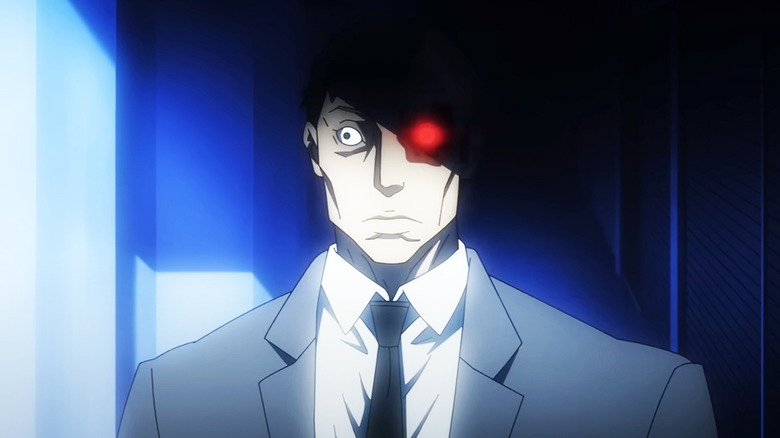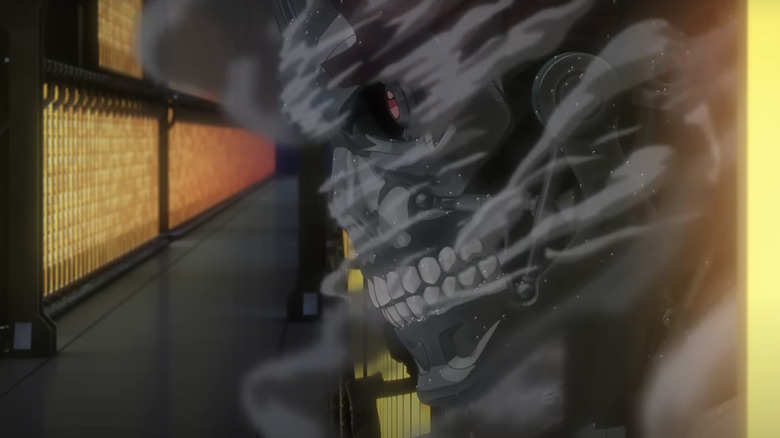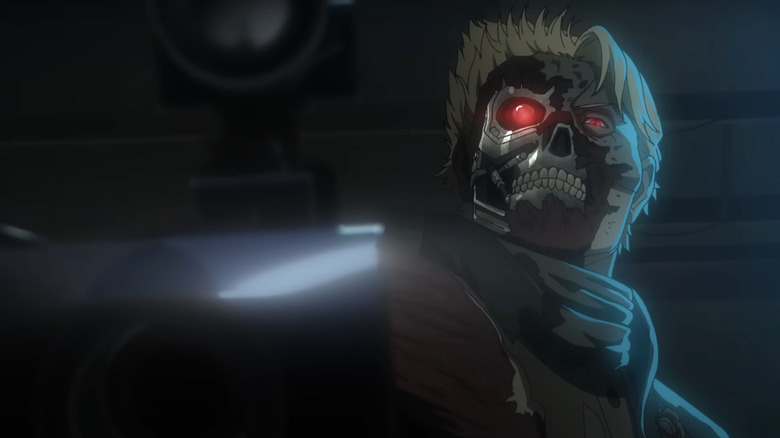After years of waiting for their franchise to get back on-track, “Terminator” fans finally have a decent on-screen installment in the long-suffering saga. After several studios tried and failed to right the “Terminator” ship, a savior arrived in the unlikely form of Netflix. The streamer’s new “Terminator Zero” anime show is a gorgeous and gruesome eight-episode series that represents showrunner/EP/writer Mattson Tomlin’s attempt to inject a bit of horror back into the franchise.
It’s an element of the original two movies that has been conspicuously absent from subsequent entries. As the “Terminator” films went on, they increasingly leaned into action blockbuster territory, jettisoning the slasher vibe creator James Cameron established with his 1984 original film, as well as the ambient sense of doom from Cameron’s 1991 sequel “Terminator 2: Judgment Day.” Thankfully, much of that is back in “Zero,” which as /Film’s BJ Colangelo writes in her review, features Timothy Olyphant’s Terminator as “a perfect reminder of just how goddamn horrifying these killing machines are and have always been.”
What makes “Zero” truly unique, though, is that Tomlin chose to set the series in Japan — leading to some unforeseen problems for “Terminator Zero’ — during an entirely new time period with entirely new characters. What’s more, the writer chose to leave John and Sarah Connor out of the narrative entirely, focusing instead on resistance soldier Eiko (Sonoya Mizuno/Toa Yukinari), who’s sent back in time to August 1997 to protect scientist Malcolm Lee (André Holland/Yûya Uchida). The result is an all-new “Terminator” tale that feels fresh while simultaneously reviving the horror that was so central to the success of the original movies. But it’s not just the horror that Tomlinson borrowed from Cameron.
The T-800 is the Terminator
In “Zero,” Malcolm Lee becomes the target of a Terminator sent back in time by Skynet. Lee will ultimately go on to create the Japanese equivalent of Skynet in the form of an AI named Kokoro (Rosario Dawson/Atsumi Tanezaki), and so future Skynet wants him dead. But rather than send back a liquid Terminator such as Robert Patrick’s T-1000 from “T2,” or a Rev-9 model as portrayed by Gabriel Luna in 2019’s “Terminator: Dark Fate,” Skynet chooses to send a good old T-800 back through time.
This is the model originally depicted by Arnold Schwarzenegger in “The Terminator,” and every subsequent sequel (though the novelization of “Terminator 3: Rise of the Machines” indicates the model in that film was actually a slightly upgraded T-850 version). This model is the Terminator, and was designed specifically to represent James Cameron’s original nightmare that inspired the series in the first place. While other Terminator designs from the films have come and gone, this original incarnation, with its hellish chrome skull and human teeth, has since become iconic and remains an enduring piece of pop culture — which has a lot to do with why Mattson Tomlin chose to use this model in his modern anime series. The Timothy Olyphant-voiced cyborg in “Terminator Zero” is indeed a T-800, which for Tomlinson was important for establishing the essence of what “The Terminator” represents.
Why Mattson Tomlin used the T-800 in Terminator Zero
Mattson Tomlin might have been tasked with taking the “Terminator” franchise in a new direction with “Terminator Zero,” but for him, bringing back the classic T-800 was never in question. Speaking to Discussing Film, the writer explained how a moment from the original 1984 “Terminator” crystalised the essence of the killer cyborg:
“Any time I was asking myself about the Terminator and, ‘What is this version of the Terminator? What the f**k am I doing?’ I would always go back to the speech that Kyle Reese gives when [he and Linda Hamilton’s Sarah Connor] are kind of ducked down there in the car, where he’s just like, “This thing can’t be reasoned with, it can’t be bargained with, it doesn’t feel pity or remorse and it will never f*****g stop… I found that to be so primal.”
In James Cameron’s original film, Michael Biehn’s Kyle Reese — who has a lot in common with Eiko from “Terminator Zero” — urges Sarah to take the threat of the Terminator seriously after he’s sent back in time to protect her. His plea speaks to the slasher villain element of the movie, with Arnold Schwarzenegger’s Terminator representing a kind of invulnerable Michael Myers figure — an emotionless, dark “shape” who remains relentless in his pursuit of Sarah. This same energy can be seen in the opening moments of “Zero,” in which Eiko battles a T-800 that has lain waste to an entire army of her comrades, and mercilessly executes the remaining few still breathing. This grizzly intro sets the tone for the rest of the episodes, too, which go on to demonstrate that if anything, the T-800 from “Zero” is even more blood-thirsty and heartless than Arnie’s version.
But it wasn’t just the relentlessness that Tomlinson was trying to emulate. As he went on to tell Discussing Film, other versions of the Terminator just weren’t quite as effective as the original. He added:
“For me, the liquid metal, it’s phenomenal, it can’t be beat — hasn’t been beat. Then we get into the nanotech stuff and I’m like, ‘It’s cool.’ […] But there’s something just about the clarity of, ‘This f*****g thing is after you and it will not stop.’ I find that to be just… you can’t argue.”







.jpeg?w=1200&resize=1200,0&ssl=1)


